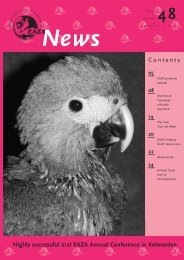EAZA Tiger Campaign extended to 2004 Contents - European ...
EAZA Tiger Campaign extended to 2004 Contents - European ...
EAZA Tiger Campaign extended to 2004 Contents - European ...
You also want an ePaper? Increase the reach of your titles
YUMPU automatically turns print PDFs into web optimized ePapers that Google loves.
programme. This paper provides a description of the<br />
techniques developed at Parco Natura Viva <strong>to</strong> moni<strong>to</strong>r vocal<br />
behaviour of mothers and infants in the nest. Recordings<br />
were made while a mother-offspring pair from three<br />
different groups were in a nest-box during three different<br />
reproductive seasons (1995/1996/2002).<br />
The nests were placed inside the enclosures eight <strong>to</strong> fourteen<br />
days before the offspring’s birth. Nests were positioned<br />
over an existing shelf and fastened <strong>to</strong> the enclosure structure.<br />
A microphone was set in each of the nest-boxes and could be<br />
linked <strong>to</strong> the tape recorder without entering the enclosure<br />
as necessary. Leaves and twigs were also introduced in<br />
the enclosure <strong>to</strong> give the female a chance <strong>to</strong> build the<br />
nest herself. Three out of four females Varecia variegata<br />
variegata and two out of two Varecia variegata rubra<br />
chose our boxes as a nest.<br />
Sample collection and analysis<br />
Recording began as soon as birth of an offspring was noted.<br />
Recordings were made four <strong>to</strong> eight hours a day during<br />
the first three days during three reproductive seasons.<br />
Recordings were computerised and split in single call files<br />
that were subsequently processed by Praat 4.0 software in<br />
order <strong>to</strong> extract spectral and temporal measures, including<br />
duration, fundamental frequency, second harmonic, third<br />
harmonic and fourth harmonic. Frequency of vocalisations<br />
was also calculated. Processed signals included 18 ‘trrs’,<br />
69 ‘whines’ and 118 ‘mews’.<br />
Spec<strong>to</strong>gram of the ‘trr’ vocalisation by infants<br />
Sound quality<br />
We compared acoustic structure of ‘mews’ emitted by mothers<br />
inside and outside the nest-box <strong>to</strong> determine whether<br />
the artificial nest allows for high quality recordings and is<br />
effective in avoiding unwanted changes in acoustic signals.<br />
None of the five parameters differed significantly between<br />
‘mews’ recorded outside and inside.<br />
Research<br />
Nest-box vocalisations<br />
We noticed that both mothers and offspring emitted ‘mews’<br />
(low amplitude contact calls), and ‘whines’ (high frequencymodulated<br />
vocalisations (Pereira et al., 1998; Gamba and<br />
Giacoma, 2001)). We identified an additional vocalisation made<br />
by infants that could not be paired with the ones previously<br />
described. We named it the ‘trr’ vocalisation. Recordings we<br />
made of this vocalisation averaged 488 ms in duration and had<br />
a very low amplitude of 40-60 dB, with no clear harmonic<br />
pattern recognisable. Infants begin emitting ‘trr’ vocalisations<br />
within six hours after the birth and only made this vocalisation<br />
when the mother was in the nest box. We never recorded<br />
this vocalisation outside the nest.<br />
Conclusions<br />
The techniques developed at Parco Natura Viva <strong>to</strong> moni<strong>to</strong>r<br />
vocal behaviour of mothers and infants in the nest allowed<br />
good quality recording of vocalisations. Spectral and<br />
temporal properties of the vocalisations were analysed <strong>to</strong><br />
phonetically describe the vocal reper<strong>to</strong>ires of mothers and<br />
offspring during the first three days after birth. Apart from<br />
already known ‘mew’ and ‘whine’ vocalisations emitted<br />
also by adults, we recorded a previously undescribed call:<br />
the ‘trr’, emitted by newborns only in the nest. Even if its<br />
function is still <strong>to</strong> be investigated, the ‘trr’ is certainly a<br />
useful indica<strong>to</strong>r of normal development. We recommend<br />
nest-box recording in lemurs as a valuable non-invasive<br />
moni<strong>to</strong>ring <strong>to</strong>ol<br />
and we stress<br />
References<br />
- Gamba, M. and C. Giacoma, 2001.<br />
its potential <strong>to</strong><br />
Vocal communication in Lemuridae,<br />
investigate early<br />
new evidences in Eulemur and Varecia.<br />
post-natal behaviour Advances in Ethology, 36. Supplement<br />
of these prosimians. <strong>to</strong> Ethology. Contributions <strong>to</strong> the XXVII<br />
International Ethological Conference,<br />
22-29 August 2001, Tübingen, Germany.<br />
- Pereira, M. Seeligson, M.L. and<br />
J.M. Macedonia, 1988. The behavioural<br />
reper<strong>to</strong>ire of the black and white ruffed<br />
lemur (Varecia variegata variegata).<br />
Folia Prima<strong>to</strong>logica 51: 1-32.<br />
Pho<strong>to</strong>: V. Jirousek<br />
<strong>EAZA</strong> News 43 – 2003<br />
29<br />
July - August - September

















